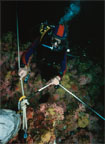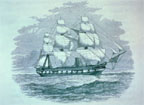|

|
Sanctuary research
at sea over Cordell Bank is conducted from
the NOAA ship McAthur. (photo: Jamie
Hall)
|
|

|
Scientists retrieve
a Tucker net which has three nets to
sample different depths and obtain
discrete samples of tiny organisms that
make up the base of the food web in the
Sanctuary. (photo: Jamie Hall)
|
|

|
Sunset on another
day of at-sea research in Cordell Bank
National Marine Sanctuary. Many
zooplankton actively migrate from deep
water into the surface layers of the
Sanctuary after dark. (photo: Jamie
Hall)
|
|

|
In the 1980's SCUBA
expeditions were led by Bob Schmieder to
undertake systematic assessments of what
dwells on Cordell Bank. (photo: Cordell
Bank Expeditions)
|
|

|
A diver from Cordell
Bank Expeditions assessing invertebrate
cover on a shallow pinnacle. (photo:
Cordell Bank Expeditions)
|
|

|
A Cordell Bank
Expeditions research diver over a bed of
filter-feeding invertebrates. The
food-rich currents over Cordell Bank offer
prime habitat for filter-feeding animals.
(photo: Cordell Bank
Expeditions)
|
|

|
Photo documentation
was a large part of the early expeditions
to Cordell Bank. (photo: Cordell Bank
Expeditions)
|
|

|
Sailing and fishing
are tow examples of multiple use of the
Sanctuary. (photo: Gulf of the Farallones
NMS)
|
|

|
A gathering of
charter sport fishing boats in Cordell
Bank National Marine Sanctuary is an
indication of lucrative yield from the
waters below. (photo: Gulf of the
Farallones NMS)
|
|

|
For many years, the
productivity around Cordell Bank has
attracted the attention of commercial
fishermen. (photo: Gulf of the Farallones
NMS)
|
|

|
An illustration of
an historic sailing vessel typical of what
used to travel through the rough waters of
Cordell Bank National Marine Sanctuary.
(photo: Gulf of the Farallones
NMS)
|
|

|
Much to the delight
of the whale watchers on board, a humpback
surfaces nearby and shows its
characteristic "hump" (photo: Dan
Howard)
|
|

|
Bird watching is a
popular past-time well rewarded in Cordell
Bank National Marine Sanctuary, especially
for pelagic or open ocean seabirds not
commonly seen anywhere else. (photo: Dan
Howard)
|
|

|
Sunset concludes
another day of experiencing the thrills of
up-close encounters with the residents of
the Sanctuary.
|
|

|
Teacher-at-Sea Karen
Duncan gets ready to deploy oceanographic
sampling equipment that will yield
information on water temperature,
salinity, and depth. NOAA's Teahcer-at-Sea
program is an ideal way to bring Sanctuary
education into classrooms well beyond the
duration of a research cruise. (photo:
Jamie Hall)
|
|

|
Portable exhibits at
environmental fairs and festivals help to
increase awareness and stimulate interest
int he Sanctuaries west of the Golden Gate
(photo: Karina Racz)
|
|

|
Visitors to an open
house aboard the NOAA ship McArthur in San
Francisco learn more about their local
Sanctuaries and the research being done by
scientists who are monitoring the health
of the marine environment. (photo: Karina
Racz)
|
|

|
On board the
McArthur, in the oceanographic lab,
visitors are provided with a close-up view
of specimens of the Cordell Bank collected
during the recent cruise. (photo: Karina
Racz)
|
|

|
Muralists Marisa
Vumbaca and Maura Garity at work on a
mural in the Sanctuary Visitor Center in
San Francisco that brings the Sanctuaries
west of the Golden Gate to city dwellers.
(photo: Amber Mace)
|
|

|
Dan Howard,
Assistant Manager of Cordell Bank, "dives"
on the mural in the visitor center. Such
an accurate rendering of what Cordell Bank
looks like makes it possible for the
general public to appreciate the diversity
and beauty that lies below, without ever
having been there. (photo: Amber
Mace)
|





